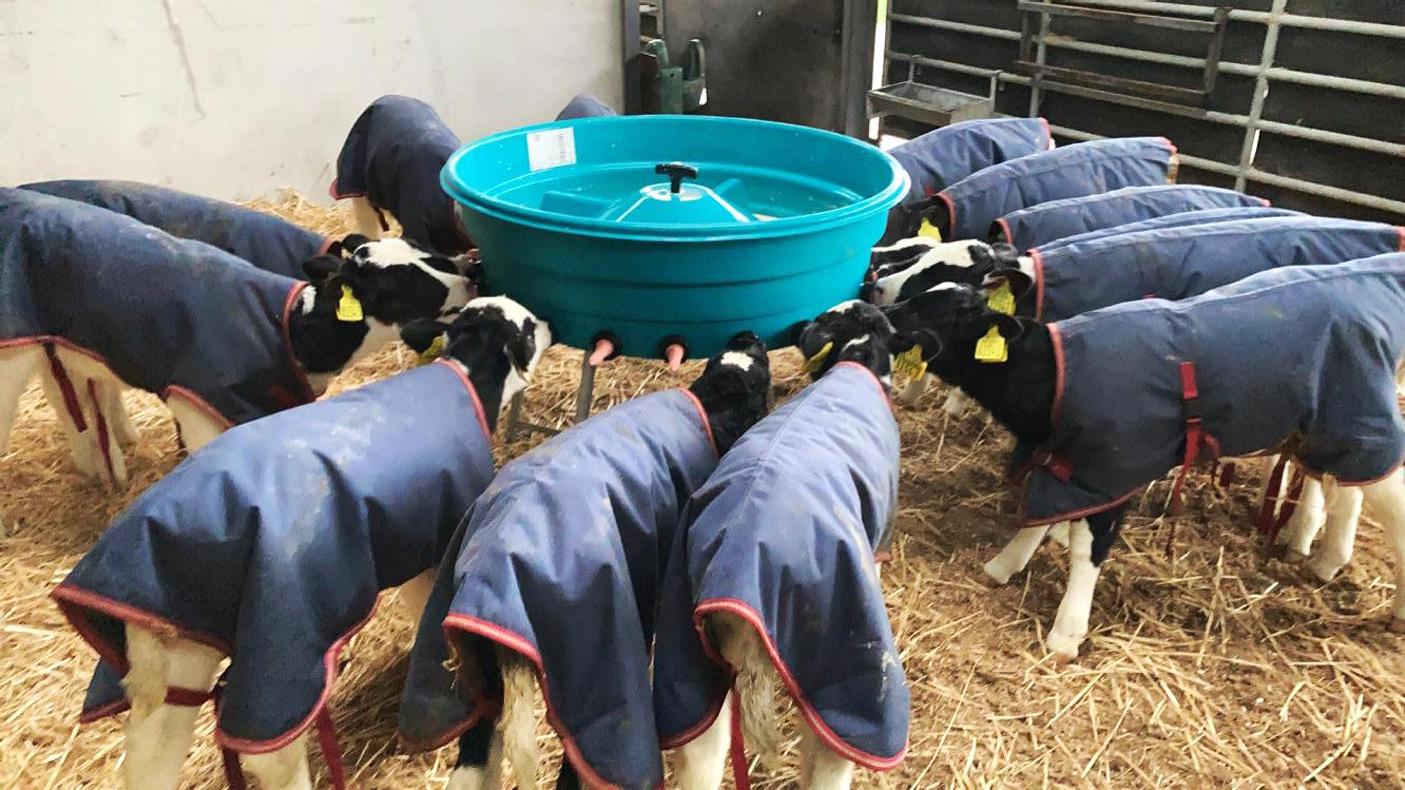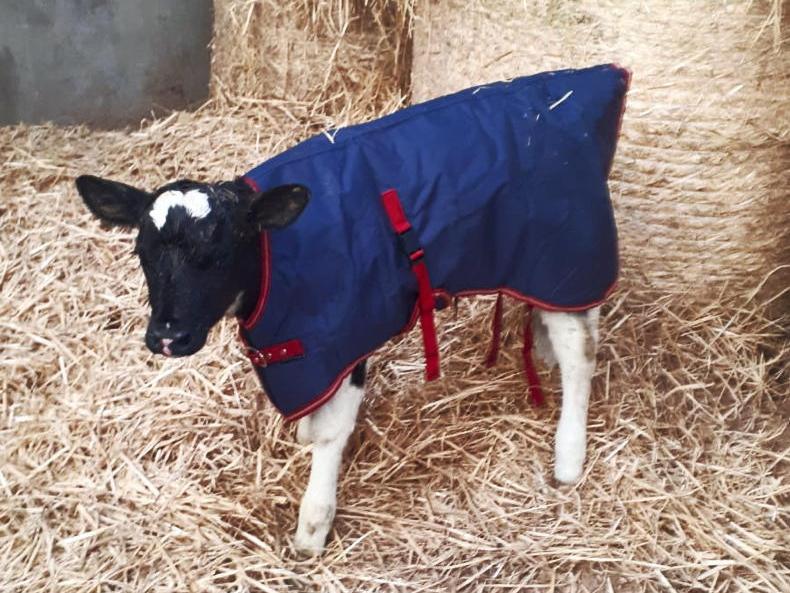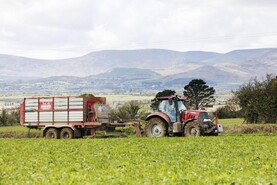There are 70 freshly calved cows going through the parlour on Frank Goodman’s farm near Carrickmacross, Co Monaghan.
Overall, 110 cows are calving down this spring and the last cow is due on 25 April.
Frank has expanded the herd from 90 cows last year and this is the first season that the entire herd will be calving down in a spring profile.
In the past, the herd had a split 80:20 spring-autumn calving pattern.
“The biggest bulk of cows calved in February and it is starting to slow down now. We have had a good run of heifers. There are 45 heifer calves on the ground so far,” Frank said.
Sexed semen was used on all maiden heifers last year and conception rate to first service stood at 67%.

Calf jackets are being used on the Goodman farm for the first time this year.
Holstein-sired calves are still arriving on the farm at present. Cows will have Limousin-bred calves from the middle of March onwards and Holstein calves will be born from the remaining heifers for another three weeks.
“Cows got out to grass by day last Monday (22 February). We had to keep them in the next day because it was wet. They were out on the Wednesday, but we housed them again once they finished grazing,” Frank said.
“Ground conditions have improved this week and cows have been able to stay out until milking time. I walked the grazing block on Monday and there is a nice cover in most paddocks. Average available cover is sitting at 860kg DM/ha,” he added.
The first slurry was spread last Saturday, and fertiliser was sown on Tuesday. Protected urea went on the milking platform and an outlaying block at 40 units per acre.

At night, cows are offered a total milked ration made up of grass silage, 5kg of maize, 3kg of blend and 0.5kg of straw. This will be fed over the coming weeks until the maize is used up, and then cows will be offered zero grazed grass after evening milking.
Zero grazing
The plan for the 2021 grazing season is to house the milking herd by night and let cows graze paddocks during the day.
The Goodman farm has a dispersed layout and the zero grazer should allow the milking herd to utilise grass on outfarms that are too far away to walk to. It explains why Frank has upped cow numbers without increasing the total area farmed.
Also, part of the grazing block can only be accessed by walking cows down a public road and this requires family assistance around milking time.
“I should be able to lift the grass myself in the middle of the day, so I won’t be waiting for extra help to put cows back out after evening milking,” Frank said.
Zero grazing took place on the Goodman farm for two months last autumn. A local contractor was used initially on a trial basis before Frank purchased his own machine.
“The contractor lifted the grass early in the morning and it was a bit wet some days. When I bought the zero grazer, I left it to the afternoon when it was usually drier, and milk yields rose by 1.1l.
“If that was the yield response with autumn milk, it should be even better in early summer,” he said.
Calving rearing in full swing
There have been no health issues in the calf shed on the Goodman farm so far this year. Frank is using calf jackets for the first time and has continued to vaccinate cows for Rotavirus prior to calving.
Two years ago, Frank had problems with scour. After investigating with his vet, it was put down to below par colostrum quality, due to a low protein content in the dry cow diet and cold night-time temperatures in the calf shed. Health issues are also being avoided by running a tight ship when it comes to hygiene. Frank makes sure pens are washed and disinfected ahead of new arrivals. Calves are also well bedded and straw bales have been positioned around group pens for added shelter.
All bulls calves born on the farm are sold after a fortnight and heifer calves will gradually be let out to paddocks beside the calf shed as the spring progresses.
Virtual Dairylink farm walk next week
A virtual farm walk is taking place on James King’s farm in Ballymena, Co Antrim, on Wednesday 10 March 2021. James runs 195 Holstein cows in a predominantly autumn-calving system.
Topics covered during the event will include plans for getting cows out to grass, improving soil fertility, nutrient management plans and managing grass throughout the grazing season.
Speakers at the event will include host farmer James King, Dairylink Ireland adviser Aidan Cushnahan and Niall McCarron from Lakeland Dairies.
The event will be broadcast at www.ifj.ie/dairylink on Wednesday 10 March at 8pm. The free webinar will also be available to watch anytime afterwards.
Cows are grazing by day on some Dairylink Ireland farms at present.Programme farmers have been spreading fertiliser, as well as slurry.Grazing blocks are being walked weekly and grass covers are being measured.
There are 70 freshly calved cows going through the parlour on Frank Goodman’s farm near Carrickmacross, Co Monaghan.
Overall, 110 cows are calving down this spring and the last cow is due on 25 April.
Frank has expanded the herd from 90 cows last year and this is the first season that the entire herd will be calving down in a spring profile.
In the past, the herd had a split 80:20 spring-autumn calving pattern.
“The biggest bulk of cows calved in February and it is starting to slow down now. We have had a good run of heifers. There are 45 heifer calves on the ground so far,” Frank said.
Sexed semen was used on all maiden heifers last year and conception rate to first service stood at 67%.

Calf jackets are being used on the Goodman farm for the first time this year.
Holstein-sired calves are still arriving on the farm at present. Cows will have Limousin-bred calves from the middle of March onwards and Holstein calves will be born from the remaining heifers for another three weeks.
“Cows got out to grass by day last Monday (22 February). We had to keep them in the next day because it was wet. They were out on the Wednesday, but we housed them again once they finished grazing,” Frank said.
“Ground conditions have improved this week and cows have been able to stay out until milking time. I walked the grazing block on Monday and there is a nice cover in most paddocks. Average available cover is sitting at 860kg DM/ha,” he added.
The first slurry was spread last Saturday, and fertiliser was sown on Tuesday. Protected urea went on the milking platform and an outlaying block at 40 units per acre.

At night, cows are offered a total milked ration made up of grass silage, 5kg of maize, 3kg of blend and 0.5kg of straw. This will be fed over the coming weeks until the maize is used up, and then cows will be offered zero grazed grass after evening milking.
Zero grazing
The plan for the 2021 grazing season is to house the milking herd by night and let cows graze paddocks during the day.
The Goodman farm has a dispersed layout and the zero grazer should allow the milking herd to utilise grass on outfarms that are too far away to walk to. It explains why Frank has upped cow numbers without increasing the total area farmed.
Also, part of the grazing block can only be accessed by walking cows down a public road and this requires family assistance around milking time.
“I should be able to lift the grass myself in the middle of the day, so I won’t be waiting for extra help to put cows back out after evening milking,” Frank said.
Zero grazing took place on the Goodman farm for two months last autumn. A local contractor was used initially on a trial basis before Frank purchased his own machine.
“The contractor lifted the grass early in the morning and it was a bit wet some days. When I bought the zero grazer, I left it to the afternoon when it was usually drier, and milk yields rose by 1.1l.
“If that was the yield response with autumn milk, it should be even better in early summer,” he said.
Calving rearing in full swing
There have been no health issues in the calf shed on the Goodman farm so far this year. Frank is using calf jackets for the first time and has continued to vaccinate cows for Rotavirus prior to calving.
Two years ago, Frank had problems with scour. After investigating with his vet, it was put down to below par colostrum quality, due to a low protein content in the dry cow diet and cold night-time temperatures in the calf shed. Health issues are also being avoided by running a tight ship when it comes to hygiene. Frank makes sure pens are washed and disinfected ahead of new arrivals. Calves are also well bedded and straw bales have been positioned around group pens for added shelter.
All bulls calves born on the farm are sold after a fortnight and heifer calves will gradually be let out to paddocks beside the calf shed as the spring progresses.
Virtual Dairylink farm walk next week
A virtual farm walk is taking place on James King’s farm in Ballymena, Co Antrim, on Wednesday 10 March 2021. James runs 195 Holstein cows in a predominantly autumn-calving system.
Topics covered during the event will include plans for getting cows out to grass, improving soil fertility, nutrient management plans and managing grass throughout the grazing season.
Speakers at the event will include host farmer James King, Dairylink Ireland adviser Aidan Cushnahan and Niall McCarron from Lakeland Dairies.
The event will be broadcast at www.ifj.ie/dairylink on Wednesday 10 March at 8pm. The free webinar will also be available to watch anytime afterwards.
Cows are grazing by day on some Dairylink Ireland farms at present.Programme farmers have been spreading fertiliser, as well as slurry.Grazing blocks are being walked weekly and grass covers are being measured. 







 This is a subscriber-only article
This is a subscriber-only article










SHARING OPTIONS: